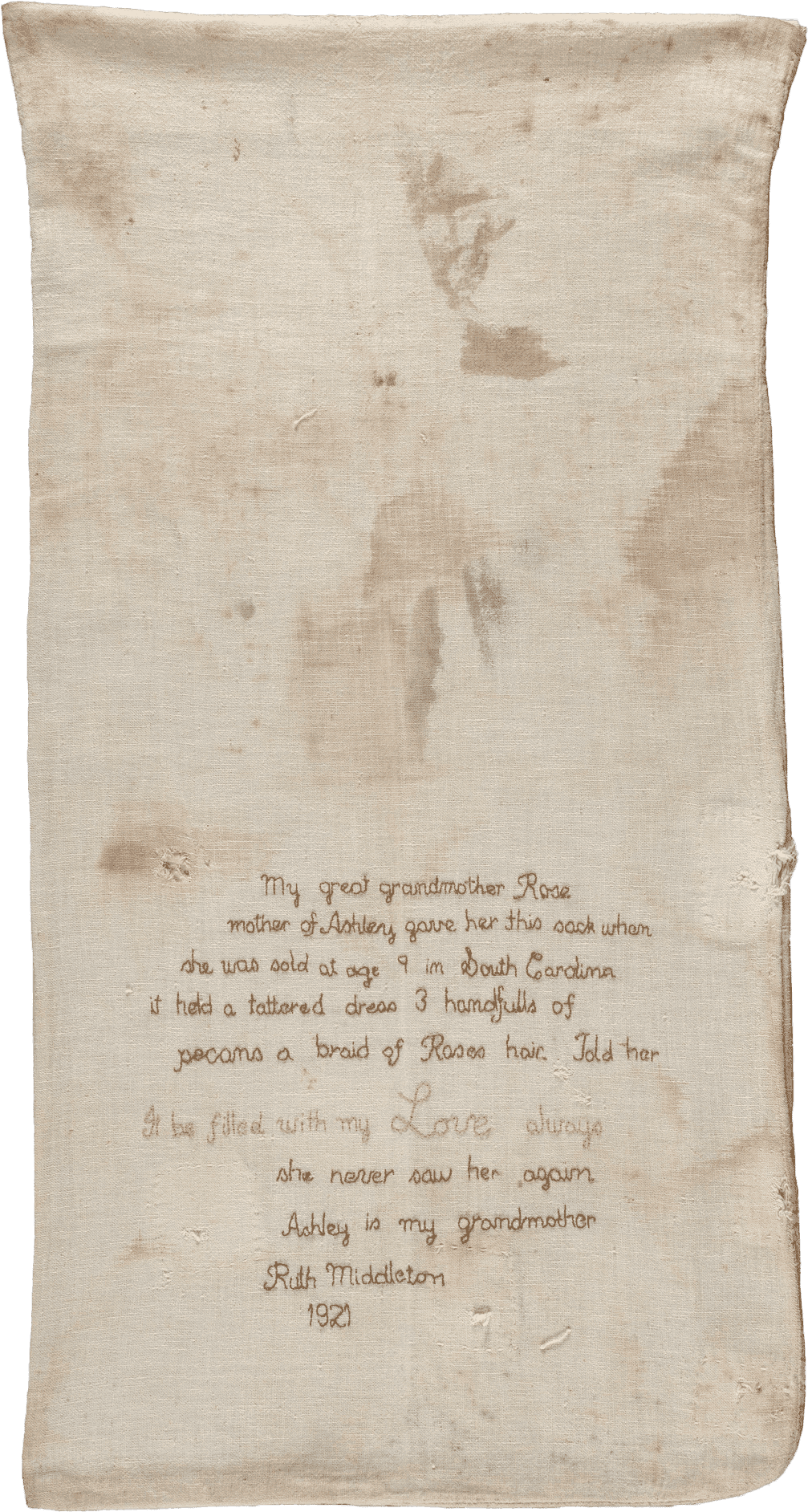Chapter 3
Domestic Slave Trade
Beginning in the late 18th century, the creation of the cotton gin, the expansion of the country, and the end of the nation’s involvement in the Transatlantic Slave Trade set the stage for an increased internal slave trade.
Between 1820 and 1860, as cotton cultivation expanded across the growing nation, roughly 1,000,000 enslaved people were torn away from their families and forced west and to the Deep South, placed on vast plantations along the Mississippi River Valley. Their labor created an empire of cotton that would transform the new nation into an economic world leader. Generations of enslaved Black people were traded on the auction block, bequeathed to relatives, sold to pay off debt, or given as gifts to young planters starting new lives. This immensely profitable trade in humans and forced migration had financial, political, and demographic repercussions still felt today.
The domestic slave trade caused immense suffering to African Americans, their families, and their communities. The desire for power and profit exacted a human cost.
The Weeping Time
Sale of Slaves, February 8, 1859
On March 2 and 3, 1859, absentee Georgia planter Pierce Butler of Philadelphia arranged for the sale of 436 enslaved Black people in Savannah, Georgia, to pay off his enormous debts. Slave dealer Joseph Bryan ran a daily advertisement announcing the sale throughout the South for a month before the event. To better accommodate the massive buyer interest, Bryan moved the sale to the local racecourse.
The enslaved men, women and children presented for sale were only half of the 900 African Americans who were enslaved by the Butler family for generations. They had not been subjected to the heartbreak of loss on the auction block until the fateful two days of sale. The historic event was a spectacle of at least 30 infants sold from their mothers, as well as spouses, elders, and siblings all torn one from another. The Weeping Time refers to the rain that fell and the tears that were shed over the two days.

When the time of parting came and I had to turn back, I burst out crying loud. I was so weak from sorrow, I could not walk.
Robert Glenn, 1937
Legacy of a Mother’s Love
Ashley’s Sack
Rose, an enslaved woman, gave this sack to her daughter Ashley before the girl was sold away. She told her it was filled with love. Ashley passed down her story to her granddaughter, Ruth Middleton, who embroidered it on the sack. Sites such as Middleton Place, a National Historic Landmark, serve as stewards of this history. Personal objects of the enslaved help to deepen our understanding of the human story of slavery.

My great grandmother Rose
mother of Ashley gave her this sack when
she was sold at age 9 in South Carolina
it held a tattered dress 3 handfuls of
pecans a braid of Roses hair. Told her
It be filled with my Love always
she never saw her again
Ashley is my grandmother
Ruth Middleton
Transcription, Ashley's Sack, 1921
Featured Video
Weeping Time
This video focuses on the Domestic Slave Trade. Excerpts from bills of sale, broadsides, and wills tell a story of the valuation of people, forced migration, and profit. Additionally, quotes from formerly enslaved men and women documented as part of the Works Progress Administration’s Slave Narratives, help tell the story of separation and strength, love and loss.
"Very Choice Cotton Plantation Slaves"
Broadside listing enslaved Black people for sale
This broadside from Lake Providence, Louisiana, advertises the sale of 56 African Americans. They include 20-month-old Henry; Nelly, age 52; and Dolly, who picked from 420 to 500 pounds of cotton per day. Enslaved people provided two sources of profit: their labor in the cotton fields and their price on the auction block.
Bequeathing Human Capital
Will of Frederick Smith, 1802
Will of Sarah B. Preston, 1847
During the antebellum period, many enslavers relocated to new land that promised new wealth in cotton and sugar cultivation. As enslavers moved to the Deep South, they brought enslaved people with them. These slaveholders strategically kept their wealth in the family and regularly bequeathed slaves in wills like this.

In consideration of the love and affection I have for my third son . . . for his better support and advancement . . . [I] give . . . two negro slaves one a girl named Jenny . . . and a boy . . . with their future increase.
Last Will and Testament of Polly Mira Poor, 1827
Ben to the Highest Bidder
Sale of Ben
Under slavery, Black men were often referred to as “boy,” regardless of their age. This insult served as a reminder that Black men were excluded from freedom, property ownership, self-reliance, and full participation in the public sphere.
“229 Rice Field Negroes”
Announcement for an estate sale at Ryan's Mart in Charleston
Many slave advertisements detailed the specialized skills of enslaved people. In the Lowcountry, generations of enslaved Black people forced from rice-growing regions in western Africa brought with them a great deal of knowledge and experience. Enslavers willingly paid higher prices for their expertise.
The Slave Auction, 1849

After the men were all sold they then sold the women and children. They ordered the first woman to lay down her child and mount the auction block; she refused to give up her little one and clung to it as long as she could, while the cruel lash was applied to her back for disobedience. She pleaded for mercy in the name of God. But the child was torn from the arms of its mother amid the most heart-rending shrieks from the mother and child on the one hand, and the bitter oaths and cruel lashes from the tyrants on the other. Finally the poor child was torn from the mother while she was sacrificed to the highest bidder. In this way the sale was carried on from beginning to end.
Henry Bibb, "Narrative of the Life & Adventures of Henry Bibb, An American Slave," Written by Himself
Rhoda Philips (ca. 1831–1906)
Rhoda Philips was born enslaved in Nashville, Tennessee. She was held in bondage from infancy until the Emancipation Proclamation in 1863, over 30 years later. This bill of sale documents the purchase of “Milley & her two Daughters” Rhoda and Martha by James Clark when Rhoda was about a year old. Shortly thereafter, enslaver Thomas Gleaves acquired Rhoda and her mother Milley. Upon Gleaves’ death in 1834, Rhoda was valued at $200 and bequeathed to his wife, Sally. She remained with Sally as a caretaker for her children until emancipation.
On the eve of the Civil War, Philips met her husband, Abram. The couple had eight children and remained in the Nashville area until her death. This daguerreotype portrays Rhoda before freedom. Her portrait challenges the inhumanity of slavery against the humanity of an enslaved woman.
Daguerreotype of Rhoda Phillips, ca. 1850
Bill of sale of Rhoda, her mother, and her siblings, 1832

Night and day, you could hear men and women screaming . . . ma, pa, sister or brother . . . taken without any warning. . . People was always dying from a broken heart.
Susan Hamilton, 1938

